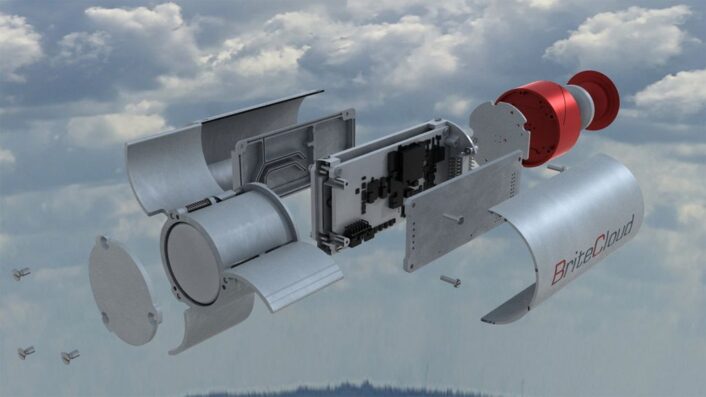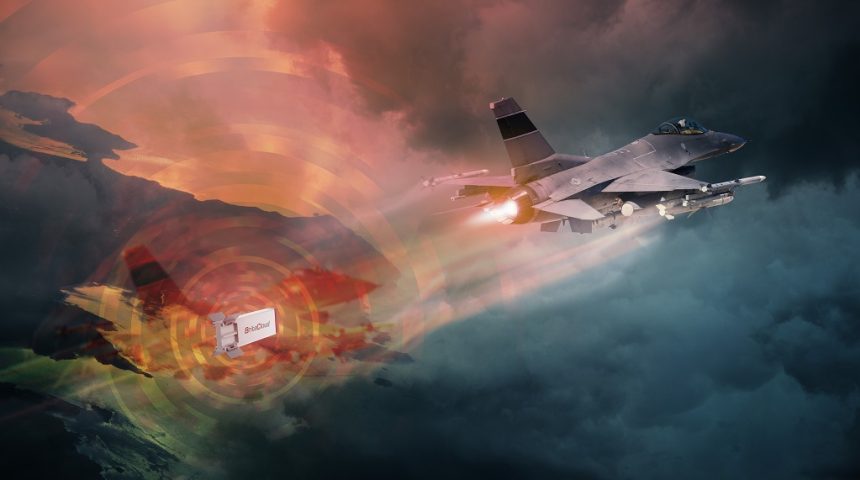The Expendable Active Decoy will be tested on US F-16s after the recent tests on Italian Tornados and Danish F-16s.
The U.S. Air Force’s Seek Eagle Office has approved Leonardo’s BriteCloud 218 Expendable Active Decoy to be flown on Air National Guard F-16C Block 30 aircraft as part of the Defense Department’s Foreign Comparative Testing (FCT) program. The operational testing program, first announced in 2019, is expected to be completed this year, with possible procurement to follow.
As we reported in an in-depth story last year, BriteCloud is a battery powered, self-contained cartridge that provides an off-board jamming capability that can be dropped like the classic chaffs and flares, creating a large distance between the aircraft and the decoy so the missile and its shrapnel miss completely the aircraft. According to Leonardo, BriteCloud has the capability to defeat the majority of RF-guided surface-to-air and air-to-air threat systems, including the ones that rely on the “home-on-jam” guidance.
After BriteCloud is ejected, it starts to search for priority threats, collecting the incoming radar pulses and cross-referencing them against a pre-programmed threat library. Upon finding a match, BriteCloud’s on-board computer applies its advanced algorithms to simulate a “false target” so accurate that the threat system cannot detect the deception and distinguish it from the real aircraft.
“BriteCloud is substantially more effective than traditional countermeasures such as chaff decoys because its technology allows BriteCloud to tailor its powerful electronic ghost signal to the specific threat radar, allowing it to defeat modern, sophisticated threats,” says Wayne Smith, vice-president of sales for electronic warfare with Leonardo.
Leonardo is currently the only company which succeeded to sufficiently miniaturize the Digital Radio Frequency Memory (DRFM) technology to the point where it can be launched from a standard 55 mm chaff and flare dispenser (“the size of a drinks can”, as the company described it). With these characteristics, BriteCloud requires minimal platform integration as it just needs to be loaded in the chaff/flare dispensers.
Following the successful tests of the 55 mm BriteCloud round, called BriteCloud 55, Leonardo developed an even smaller variant called BriteCloud 218 which can fit the 2”x1”x8” US-made chaff/flare dispensers. The FCT tests will use the BriteCloud 218 round, which fits the standard AN/ALE-47 countermeasure dispensers installed on the F-16.

The latest milestone for the program was announced at Singapore air show. In the same occasion, as geopolitical tensions in the Asia-Pacific region continue to build, Leonardo said in a press release it is in discussion with a number of operators internationally to upgrade the region’s more than 500 F-16 fighters with the BriteCloud 218 decoy without needing to modify the platform or perform expensive integration work. The company declined to name the nations involved.
A recent press release from Leonardo also mentioned that two Italian Air Force Tornados and a Royal Danish Air Force F-16 Fighting Falcon visited RAF Coningsby during October 2021 for trials with the BriteCloud EAD: “Leonardo and the UK Royal Air Force have successfully demonstrated new high-tech deception techniques using its drinks-can-sized BriteCloud countermeasure, in co-operative trials with the Italian and Royal Danish Air Forces.”
The Italian Air Force fired BriteCloud 55 rounds from Tornado IDS aircraft and the Royal Danish Air Force dispensed BriteCloud 218 rounds from an F-16 fighter at the RAF Donna Nook air weapons range in Lincolnshire. “The new techniques proved highly effective at the trials range and the positive results will be presented to other NATO nations in an operators’ forum”, Leonardo mentioned.
According to spotters arrived at RAF Coningsby to see the visiting aircraft, the Italian Tornado IDS aircraft were MM7036/6-06 and MM7023/6-63, assigned to the 6°Stormo at Ghedi Air Base. The Tornados used the radio callsign “Spera”, meaning they were being flown by aircrew from 311° Gruppo Volo of the Reparto Sperimentale Volo (RSV), the Italian Air Force’s flight test unit. The Royal Danish Air Force F-16AM taking part in the same trials was identified as E-598.
These tests also follow the integration of BriteCloud on the MQ-9A Reaper and MQ-9B Sky/SeaGuardian series UAVs. General Atomics’ MQ-9 became the first RPAS to employ BriteCloud, with a test campaign in late 2020 that saw the Reaper successfully releasing a number of inert decoys during carriage and release trials from the new Self-Protection Pod.









